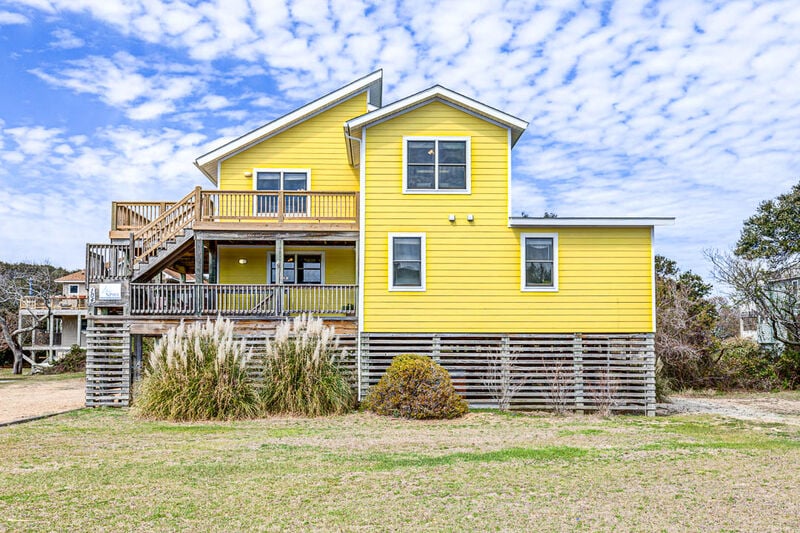
Did you know that more than 2,000 ships have wrecked off theOuter Banks? No wonder this storied coastline is known as the "Graveyardof the Atlantic."
The earliest known shipwreck occurred way back in 1526. Thelatest occurred in 2012 in the midst of Hurricane Sandy.
Throughout the intervening centuries, all kinds of vessels -from schooners to steamers to battleships - have sunk in these turbulentwaters. Some broke up in stormy waves. Others ran aground onshore, where relentlesssurf pounded them into pieces. Still others were sabotaged by professional"wreckers" or torpedoed by German U-boats.
Today you can still see the ruined remains of some of these ill-fatedships. Many are visible from shore. Others are buried deep underwater, whereyou can explore them through guided scuba-diving expeditions.
Whether you observe them above or beneath the waves, you'll get an unforgettable glimpse of a thrilling seafaring heritage.
Famous Outer Banks Shipwrecks Include:
- Adventure (wrecked 1718), a sloop commanded by Edward Teach, the infamous pirate Blackbeard, which ran aground near Beaufort Inlet.
- El Salvador (wrecked 1750), a Spanish galleon carrying four chests of gold coins and 16 chests of silver coins - 240,000 pesos in all. Its gold and silver treasure has never been recovered.
- USS Monitor (wrecked New Year's Eve, 1862), the legendary Union ship, famous for its "battle of the ironclads" with the Confederacy's Virginia / Merrimack. Sunk during a raging storm southeast of Cape Hatteras, it was discovered - disintegrating deep underwater - during the early 1970s.
Why Were There So Many Shipwrecks?
What has made this legendary coast so treacherous for mariners? Several factors play a role:
- Clash of two currents: Right around Cape Hatteras, two mighty forces meet - the icy Labrador Current, surging down from the north, and the balmy Gulf Stream, flowing up from the tropical south. Where these two currents collide, huge waves roil the ocean, especially during storms.
- Diamond Shoals: Just off Hatteras Island lies a series of underwater sandbars, spreading for miles in varying directions. Known as Diamond Shoals, these sandbars constantly shift amid rough waves and rushing currents. Since their depth changes as they shift, the waters above are often shallower than they seem... so unwary mariners sometimes run aground before realizing their peril.
- Hurricanes: Fueled by warm, moist air, massive tropical cyclones - a/k/a hurricanes - form in the Gulf of Mexico, often between June and November. When these storms hit the Outer Banks, they can wreak incredible havoc - especially for ships and sailors caught in the waves and crosswinds.
Despite these hazards, countless seafarers brave these commercially vital waters. In response, the US government has taken steps to ensure mariners' safety. Since the early 19th century, seven light stations have been built along the Outer Banks. (Five of these lighthouses remain.)
Plus, in 1871, US and local officials formed a life-saving rescue service - which later merged with other services to become the US Coast Guard.
Discover Awesome Shipwrecks You Can Easily See from Shore
Looking for shoreline shipwreck excursions suitable for theentire family? You're in luck. Several wrecks are readily accessible,including:
- Margaret A. Spencer: No one knows exactly when this wooden ship capsized. But today it lies stranded - and easily visible - at the shoreline about 14 miles south of the Oregon Inlet Campground.
- The Triangle Wreck: In 1927, the Greek tanker Kyzickes shipwrecked at Kill Devil Hills. Two years later the freighter Carl Gerhard rammed into the wrecked Kyzickes, tearing it into two pieces. Today both ships lie 200 yards offshore in about 20 feet of water. Together, they form a triangle shape; hence their nickname "The Triangle Wreck."
- USS Huron: Wrecked in 1877, this gunship steamer sits about 20 feet deep 200 yards off the beach at Nags Head. Roughly 100 yards further north lies the tugboat Explorer, shipwrecked in 1919.
- The Boiler Wreck: Wrecked in 1862, during the Civil War, the Union steamship Oriental lies about 150 yards off of Pea Island National Wildlife Refuge in Rodanthe, where its boiler and smokestack are visible in the surf.
Dive to Discover Buried Shipwrecks
Love to scuba dive? Dive centers all along the Outer Banks provide chartered diving excursions to view famous submerged vessels. Most charters cater to all levels, novice to advanced. Check out Ghost Fleet Divers in Wanchese, Roanoke Island Outfitters in Manteo, and Discovery Diving in Beaufort, among others.
Don't Miss the Graveyard of the Atlantic Museum
Can't get enough of that romantic shipwreck lore? Visit the Graveyard of the Atlantic Museum at 59200 Museum Drive in Hatteras Village. Open Monday to Saturday, 10 a.m. to 4 p.m., this state-of-the-art museum houses numerous "Ghost Fleet" artifacts retrieved from sunken vessels, along with fascinating exhibits showcasing maritime history.
Stunning highlights include:
- The restored Laura A. Barnes, a four-masted schooner wrecked in 1921 and later excavated from Coquina Beach
- The original 1854 First Order lens from the Cape Hatteras Lighthouse
And more! Plus, throughout the year, special interactive programs bring the coast's rich heritage to life. Admission is free for all ages.
Visit the North Carolina Outer Banks Now
Gather your family, head for the OBX, and discover the Graveyard of the Atlantic.









